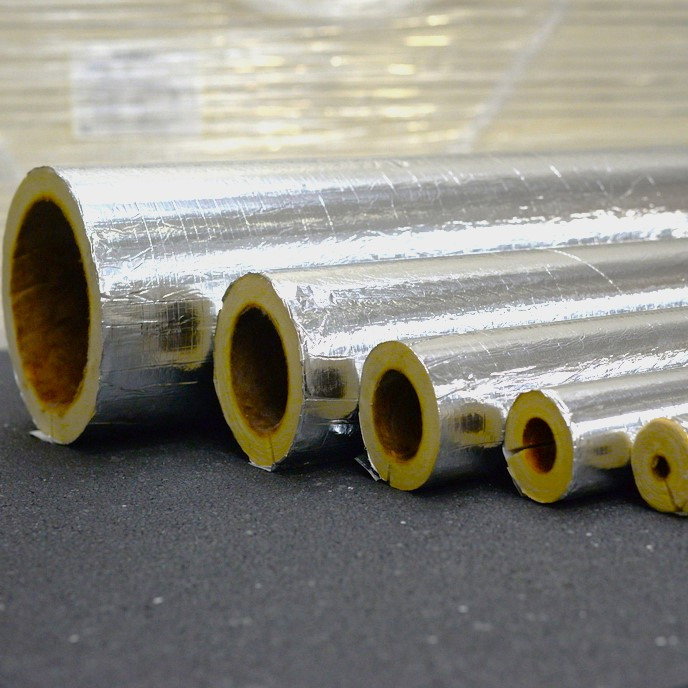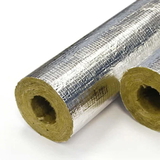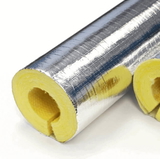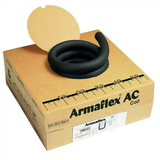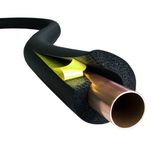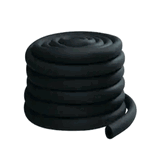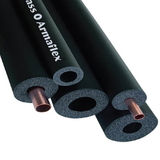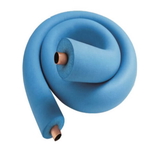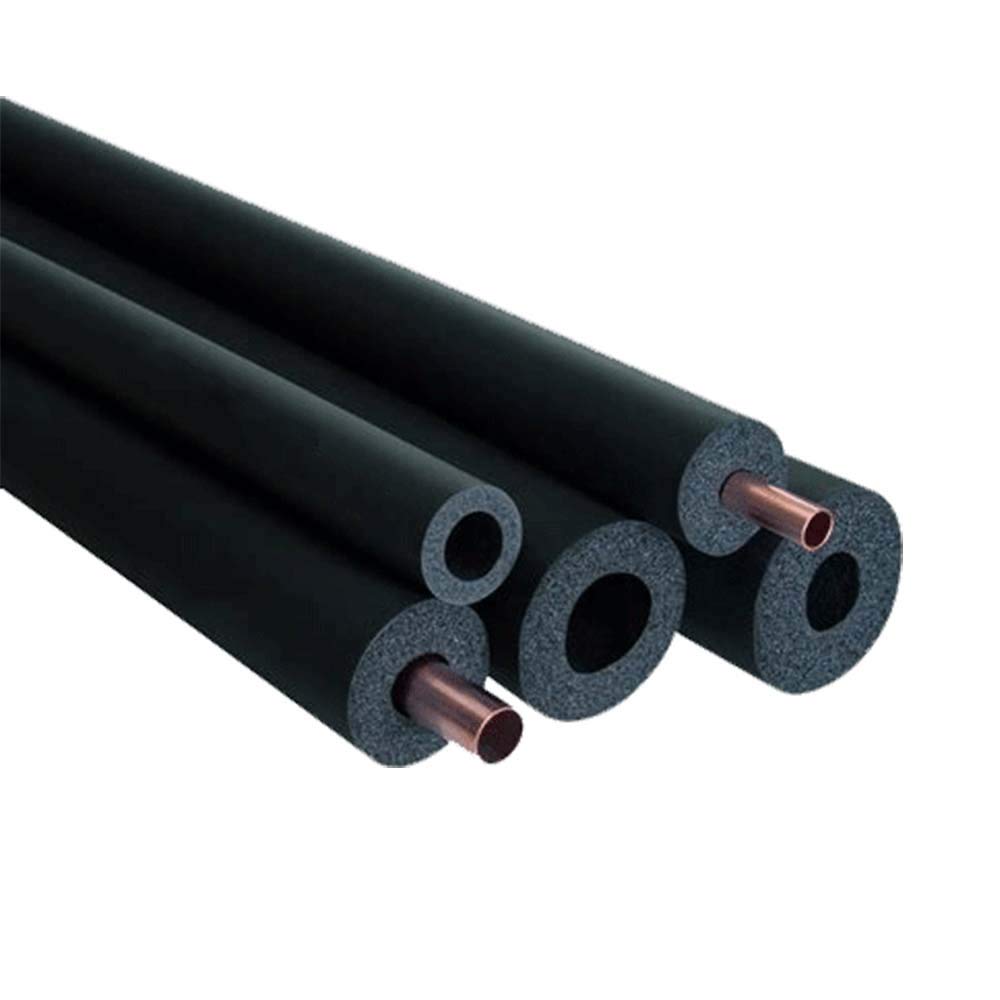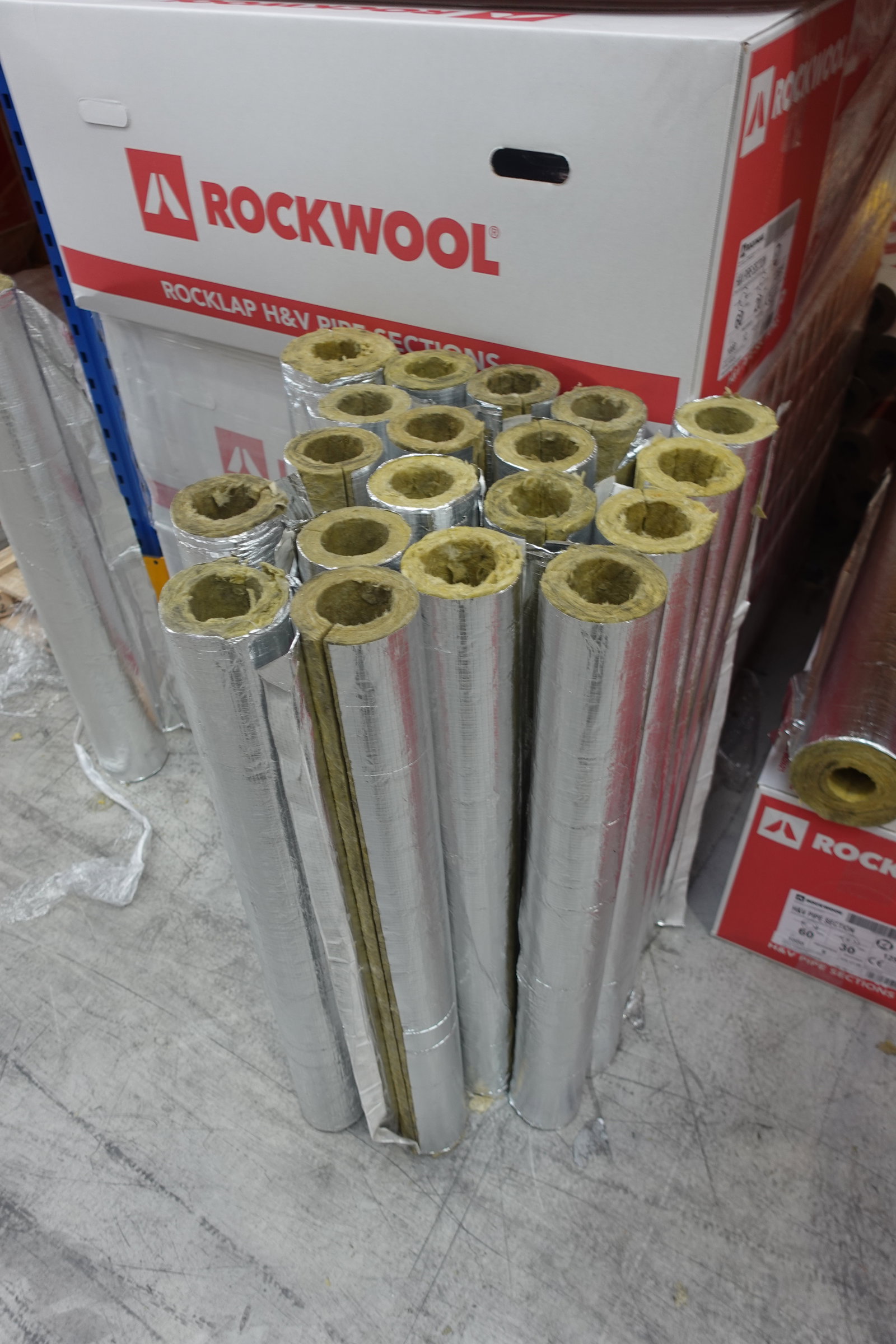- Blogs
- A Professional's Guide to Pipe Insulation: Fibreglass vs. Alternatives in the UK
A Professional's Guide to Pipe Insulation: Fibreglass vs. Alternatives in the UK
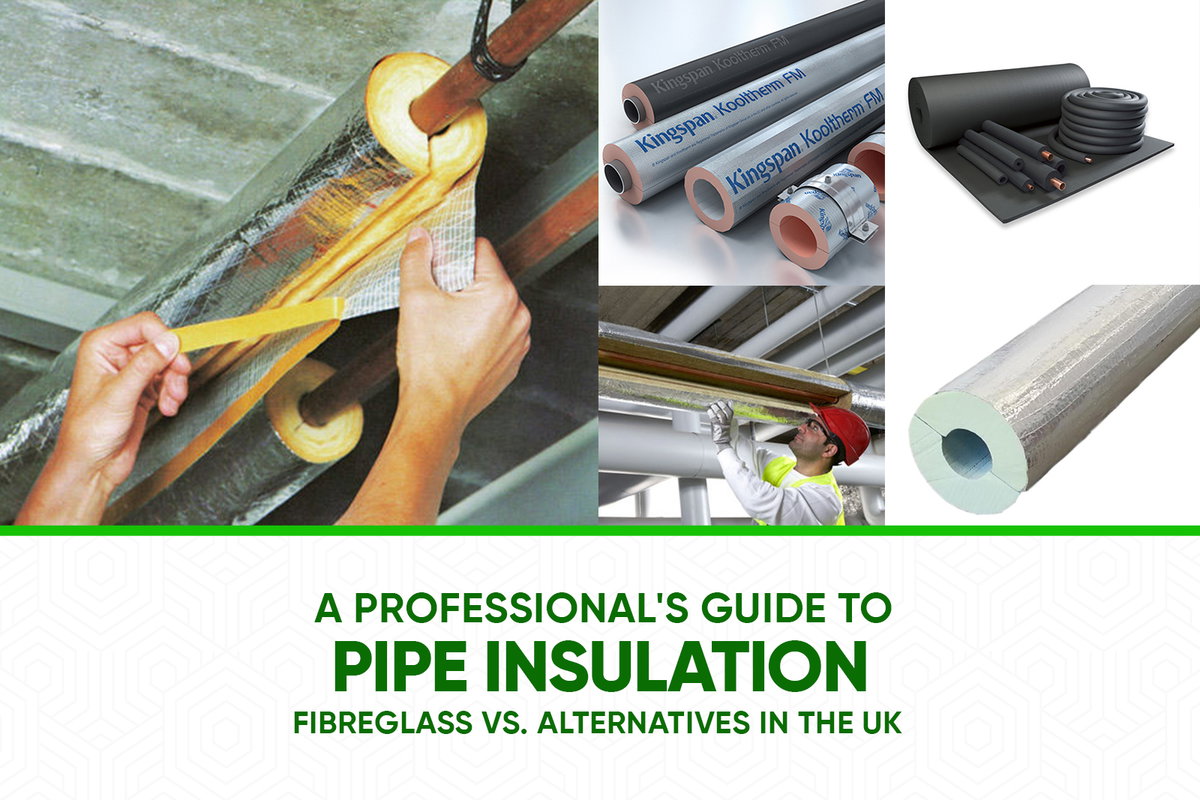
TLDR
-
Fiberglass & Mineral Wool: These materials are the primary choice for high-temperature applications such as central heating, district heating, and steam pipework. Their key strengths are excellent thermal performance at high temperatures and non-combustibility, typically achieving a Euroclass A1 or A2 fire rating. They are not suitable for chilled or cold water lines where condensation control is the main objective.
-
Nitrile Rubber: This is the specialized material for cold and chilled water systems, air-conditioning, and refrigeration lines. Its closed-cell structure provides an integral vapour barrier, which is essential for preventing surface condensation and subsequent moisture damage or corrosion. It offers good flexibility and a Class O fire performance rating.
-
Polyethylene Foam: A cost-effective and highly flexible insulation, commonly used for general-purpose domestic hot and cold water pipes. It provides effective frost protection and is easy for professionals and competent DIYers to install. Its fire performance is lower than other materials.
-
Phenolic Foam: This material provides the highest level of thermal efficiency for a given thickness. It is the optimal solution for projects where space for services is limited but high thermal performance is still required to meet regulatory standards.
-
Compliance is Mandatory: In the UK, pipe insulation is governed by a combination of legal requirements and standards. Building Regulations Part L dictates which pipes must be insulated to conserve energy. The British Standard BS 5422:2023 provides the technical method for specifying the minimum thickness of insulation required to meet performance targets for heat loss, condensation control, or frost protection. Adherence to both is essential for compliant building services.
Buy Fibreglass Pipe Insulation
Introduction: Selecting the Right Pipe Insulation![]()
The specification of pipe insulation is a critical aspect of building services design and installation. The primary function is to manage heat transfer, which directly contributes to the energy efficiency of a building's heating, ventilation, and air-conditioning (HVAC) systems. Correctly insulated pipework reduces heat loss from heating and hot water systems and prevents unwanted heat gain in chilled water and refrigeration lines. This management of thermal energy translates into lower operational costs and a reduced carbon footprint for the building.
Beyond energy conservation, pipe insulation serves several other vital functions. It provides frost protection for pipes in unheated spaces, preventing freezing and potential bursts, which can cause significant water damage. It is also a key component in controlling surface condensation on cold pipework, which, if left unchecked, can lead to moisture damage, corrosion of pipes and fixtures, and the growth of mold. Additional benefits include personnel protection from high-temperature surfaces and a degree of acoustic insulation, dampening the noise of fluid flow within the pipes.
The selection of an appropriate insulation material is not a one-size-fits-all decision. A specifier must evaluate a range of factors to arrive at the correct solution for a given application. These include the operating temperature of the service, the ambient conditions and potential for moisture, the required fire safety performance, any acoustic considerations, and the physical space available for the installation.
An effective insulation specification considers the entire installation as a complete system, not just an individual product. The performance of the insulation material itself can be compromised without the correct specification and application of complementary components. This includes appropriate facings, such as factory-applied foil, which can act as a vapour barrier and provide a low-emissivity surface. It also includes the correct adhesives, sealing tapes, and, where necessary, protective mechanical cladding. The integrity of joints and seams is paramount; a failure at these points can create thermal bridges or allow moisture ingress, undermining the performance of the entire system.
A Detailed Look at Fibreglass Pipe Insulation
Fiberglass pipe insulation is a widely specified material in the UK, particularly for thermal applications involving heated services. A thorough understanding of its composition, performance characteristics, and limitations is essential for its correct application.
Material Composition
Fiberglass insulation is manufactured from fine strands of glass, which are spun into a fibrous, wool-like texture. These fibers are then bound together using a resin to form preformed pipe sections or flexible blankets. A significant portion of the raw material is often recycled glass, with some products containing up to 80% recycled content. The material is also recyclable at the end of its service life, which can contribute to the sustainability credentials of a project.
Key Properties and Performance Characteristics
-
Thermal Performance: Fiberglass is engineered for effective thermal management, excelling at reducing heat loss from hot pipework. It has a broad service temperature range, performing effectively in applications from approximately 5°C up to 500°C, making it suitable for a wide array of heating and process systems.
-
Fire Safety: A key characteristic of fiberglass is its non-combustible nature. It does not contribute to fire and has a very high melting point. Consequently, it typically achieves a high Euroclass Reaction to Fire classification, such as A1 or A2-s1,d0, signifying the highest level of fire safety performance. This provides an important layer of passive fire protection within a building's service voids and plant rooms.
-
Acoustic Insulation: The dense, fibrous matrix of fiberglass insulation is effective at absorbing sound energy. This property makes it useful for reducing the noise generated by fluid flow, particularly in wastewater, soil, and drainage pipes, contributing to the acoustic comfort of building occupants.
-
Moisture and Condensation: Fiberglass insulation has an open-cell structure. This means it is not inherently resistant to moisture ingress. While it can help protect pipework from some effects of ambient humidity, it is not designed to act as a vapour barrier on its own. For this reason, it is not considered the ideal material for chilled water applications or for preventing pipe freezing where condensation is a significant risk.
Advantages and Limitations in UK Applications
Fibreglass insulation presents a strong profile for specific applications. Its advantages include being a cost-effective solution that is lightweight and relatively easy to handle and install. It is compatible with all common pipe materials, including copper, steel, and plastics. The availability of sections in 1.2-metre lengths, as opposed to 1-metre, can help to reduce the number of joints on a long pipe run, thereby minimizing potential thermal bridges.
The principal limitation of fibreglass is its performance in the presence of moisture. Its open-fibre structure can absorb and hold water if its protective facing is breached, which would severely degrade its thermal insulating properties. This makes it unsuitable for applications below ambient temperature, such as chilled water lines, where surface condensation will occur. In these scenarios, a closed-cell insulation material with an integral vapour barrier is required. This positions fiberglass not as a general-purpose insulator but as a specialist material for high-temperature services. For a professional specifier, this means fibreglass is the correct choice for plant rooms, boiler houses, and heating distribution pipework, but an alternative material must be selected for the chilled water and refrigeration pipework within the same building.
Typical Use Cases
Given its performance profile, fiberglass pipe insulation is widely used across residential, commercial, and industrial settings. Its primary applications are for hot services, including:
-
Low, medium, and high-temperature heating systems.
-
Domestic hot water systems.
-
Solar thermal pipework.
-
High-temperature steam pipes in industrial or district heating contexts.
Common Alternatives to Fibreglass Insulation
While fibreglass is a key material for high-temperature applications, several other insulation types are commonly used in the UK, each with a distinct performance profile that makes it suitable for different scenarios.
Mineral Wool (Rock/Stone Wool) Insulation
Mineral wool, often referred to by brand names such as Rockwool, is produced from molten volcanic rock (basalt) and recycled industrial slag, which are spun into fine fibers. Its composition and manufacturing process are similar to fiberglass, and it shares many of the same core properties. It is dense and non-combustible with a very high melting point (often over 1000°C), and achieves a top Euroclass A1 fire rating.
In comparison to fiberglass, mineral wool is often considered to have slightly superior acoustic insulation properties due to its higher density. Like fiberglass, it is an open-cell material and relies on a factory-applied foil facing to act as a vapour barrier. Its primary applications are identical to those of fiberglass: insulating high-temperature pipework for heating, hot water, and steam services, where its fire safety and thermal performance are most valued. It is also not recommended for chilled water lines.
Polyethylene (PE) Foam Insulation
Polyethylene foam is a flexible, closed-cell thermoplastic insulation. The closed-cell structure means it is composed of millions of tiny, discrete air bubbles, which gives the material an inherent resistance to moisture absorption. It is lightweight, highly flexible, and typically supplied in pre-slit tubes, making it very easy and quick to install.
PE foam is a cost-effective choice for general-purpose domestic applications. Its typical operating temperature range is between approximately -45°C and +105°C, making it suitable for standard domestic hot and cold water pipes. It is particularly effective for providing frost protection to pipes in unheated areas like lofts and garages. A key point of differentiation from fibreglass and mineral wool is its fire performance. Standard PE foam is combustible and will typically have a Euroclass E rating. It can also degrade if exposed to direct sunlight over long periods, so it requires protection if used externally.
Nitrile Rubber Insulation ![]()
Nitrile rubber is a flexible, elastomeric foam based on a synthetic rubber. Like polyethylene, it has a closed-cell structure, but it offers a higher degree of water vapour resistance. This effectively gives the material a built-in vapour barrier, making it exceptionally good at preventing surface condensation.
This characteristic is its main advantage and defines its primary use. Nitrile rubber is the industry-standard material for insulating chilled water lines, refrigeration pipework, and air-conditioning systems. In these applications, the pipe surface temperature is below the dew point of the ambient air, and condensation will form without a completely sealed, vapour-proof insulation system. Nitrile rubber provides this protection. It also has good fire performance, typically achieving a Class O rating under UK Building Regulations, which relates to low surface spread of flame and limited heat release. Its flexibility makes it easy to form around valves and fittings, ensuring a complete seal.
Phenolic Foam Insulation
Phenolic foam is a rigid, closed-cell insulation with a very fine cell structure. This microstructure gives it an exceptionally low thermal conductivity (λ-value), meaning it is more thermally efficient than other common insulation materials for a given thickness.
The primary benefit of phenolic foam is its ability to provide high levels of thermal insulation with a much slimmer profile. This makes it the ideal solution for applications where space is at a premium. Modern construction trends often involve routing more services through smaller, more congested risers and ceiling voids. At the same time, regulations such as BS 5422 have become more stringent, often requiring thicker insulation to achieve compliance. This combination of factors creates a scenario where traditional, bulkier insulation types may not physically fit. While phenolic foam has a higher initial material cost, it can become the most effective overall solution when the need to meet strict thermal targets within a constrained space is the primary design driver. Its typical applications include high-performance HVAC systems and heating pipework in space-restricted areas.
Comparative Analysis of Pipe Insulation Materials
Choosing the correct insulation requires a comparative assessment of material properties against the specific demands of the application. The following table and analysis provide a direct comparison of the most common materials used in the UK.
Table 1: Comparative Overview of Common Pipe Insulation Materials
Feature |
Fibreglass |
Mineral Wool |
Polyethylene (PE) Foam |
Nitrile Rubber |
Phenolic Foam |
| Material Type | Spun glass fibre wool | Spun volcanic rock fibre wool | Closed-cell thermoplastic foam | Closed-cell elastomeric rubber foam | Rigid closed-cell thermoset foam |
| Key Characteristics | Non-combustible, high-temp resistant | Non-combustible, high-temp, good acoustics | Flexible, cost-effective, easy to install | Flexible, built-in vapour barrier, good fire rating | Highest thermal efficiency per unit thickness |
| Typical Operating Temp. Range | +5°C to +500°C | 0°C to +250°C (higher grades available) | -45°C to +105°C | -50°C to +110°C | -50°C to +120°C |
| Fire Rating (Typical Euroclass) | A1 or A2 | A1 or A2 | E | B/C (Class O equivalent) | B/C |
| Moisture Resistance | Poor (requires separate vapour barrier) | Poor (requires separate vapour barrier) | Good (closed-cell) | Excellent (closed-cell, integral vapour barrier) | Excellent (closed-cell) |
| Primary UK Application | Central heating, steam pipes, industrial hot processes | Heating pipes, HVAC ductwork, acoustic insulation | Domestic hot/cold water, frost protection | Refrigeration, AC, chilled water, condensation control | High-efficiency HVAC, space-constrained applications |
Detailed Comparison Across Key Metrics
Thermal Efficiency and Operating Temperature
The operating temperature of the pipe is the first determinant in material selection. For high-temperature services, such as district heating primaries, steam lines, or some industrial processes, fibreglass and mineral wool are the only suitable options due to their high temperature resistance. For the majority of domestic and commercial heating systems (operating below 100°C), all materials could be considered from a temperature perspective. However, phenolic foam offers the best thermal performance for its thickness, having a lower thermal conductivity (λ) value than the other materials. This means a 20 mm thick phenolic insulation will provide more effective insulation than a 20 mm thick section of PE foam or nitrile rubber.
Fire Safety Performance
Fire safety is a non-negotiable aspect of material specification in commercial and multi-occupancy residential buildings. The Euroclass system, which is referenced in UK Building Regulations, classifies materials from A1 (non-combustible) to F (easily flammable).
Fibreglass and mineral wool sit at the top of this classification with an A1 or A2 rating, meaning they make no contribution to a fire. This is a significant advantage in safety-critical areas. Phenolic foam and nitrile rubber typically achieve a Euroclass B or C, which signifies limited combustibility and is acceptable for most building service applications. The UK-specific 'Class O' rating, often applied to nitrile rubber, is a performance-based measure under BS 476, which demonstrates a low surface spread of flame and is generally considered to meet the requirements of the Building Regulations for circulation spaces. Standard polyethylene foam has the lowest fire performance, typically a Euroclass E, and its use may be restricted in certain applications.
Moisture and Condensation Resistance
The structure of the insulation material is critical for its performance in moist environments or on cold pipes. Fibreglass and mineral wool are 'open-cell' materials; their fibres create a wool-like matrix that can absorb and hold water if exposed. They must be protected by a completely intact, sealed vapour barrier (such as the factory-applied foil facing) to prevent moisture ingress.
In contrast, polyethylene, nitrile rubber, and phenolic foam are 'closed-cell' materials. Their structure consists of individual, sealed pockets of gas. This makes them inherently resistant to absorbing water. Nitrile rubber offers the highest resistance to water vapour transmission, which is why it is the default choice for preventing condensation on chilled water and refrigeration lines.
Acoustic Performance
While all insulation provides some level of sound dampening, the dense, fibrous structure of mineral wool and fibreglass makes them particularly effective at absorbing sound waves. They are often specified where reducing noise from pipework is a specific design goal, for example, on large-diameter drainage stacks or on pipework running through acoustically sensitive areas.
Navigating UK Standards and Regulations![]()
Compliance with UK standards and regulations is a mandatory part of any professional pipe insulation installation. The two key documents that govern this are the British Standard BS 5422 and the Building Regulations Approved Document L.
Understanding BS 5422:2023
BS 5422, with the latest version published in 2023, is the British Standard that provides a "Method for specifying thermal insulating materials for pipes, tanks, vessels, ductwork and equipment". It is not a legal document in itself, but it is the primary technical reference used to meet the legal requirements of the Building Regulations. Its purpose is to provide a standardised method for calculating the minimum insulation thickness required to achieve a specific performance outcome, such as:
-
Controlling heat loss from a heating pipe.
-
Controlling heat gain to a chilled water pipe.
-
Preventing the surface temperature of a cold pipe from falling below the dew point (condensation control).
-
Providing a minimum period of frost protection.
The 2023 version introduced several important changes from the previous 2009 edition. Key updates include:
-
Euroclass Fire Ratings: The standard now references the European fire classification system (Euroclasses) exclusively, replacing the old UK 'National Class' ratings.
-
Simplified Tables: The thickness tables have been consolidated, removing separate tables for copper and steel pipes.
-
Enhanced Performance Tables: The standard now includes optional 'enhanced' tables, which set more stringent performance targets for greater energy savings.
-
District Heating: New, specific tables have been added for district heating systems.
-
Plastic Pipes: A significant change is that single-wall plastic pipes are now considered to have no inherent insulating value. The insulation specified must provide the total required thermal resistance on its own.
To use the standard, a specifier must identify the pipe size, the system's operating temperature, and the emissivity of the insulation's outer surface (a low value for a shiny, reflective foil finish, and a high value for a plain, non-reflective surface). These parameters are used to find the required minimum insulation thickness from the relevant table in the standard.
Compliance with Building Regulations Part L (Volume 1: Dwellings)
Approved Document L of the Building Regulations, "Conservation of fuel and power", sets the legally enforceable energy efficiency standards for buildings in England. Volume 1 specifically covers dwellings.
Part L mandates which pipes must be insulated. For new dwellings, this includes all primary circulation pipes for heating and domestic hot water, as well as pipes connected to a hot water storage vessel for at least one metre from the vessel. For work in existing dwellings, such as the replacement of a boiler or hot water cylinder, any accessible associated pipework should be insulated at the same time.
The regulation then states that the heat loss from this insulated pipework must not exceed the levels specified in BS 5422. It provides a simplified table of minimum thicknesses for common situations but defers to the full BS 5422 standard for comprehensive compliance.
The relationship between the two documents is fundamental to compliance. Part L provides the legal requirement to insulate specific pipework. BS 5422 provides the detailed technical methodology to ensure the insulation is specified correctly to meet the performance required by law. An installation is only compliant if the right pipes are insulated with the correct material at a thickness that meets or exceeds the minimum calculated according to BS 5422 for that specific application.
Best Practices for Installation and Maintenance
The theoretical performance of a specified insulation material can only be achieved through correct and careful installation. Poor workmanship can lead to thermal bridges and gaps in vapour barriers, compromising the entire system.
Preparation and Tools
Professional results begin with proper preparation. The first step is to accurately measure the outside diameter of the pipe to ensure the insulation is the correct size. The bore of the insulation should match the pipe's outer diameter for a snug fit. The total length of the pipe runs should be measured to procure the correct quantity of material.
Essential tools include a sharp knife or blade (a serrated blade is often effective for mineral wool), a measuring tape, and the correct sealing materials. For foil-faced products, a matching foil tape is required. For non-adhesive foam products, a suitable contact adhesive may be needed. Using a blunt knife will tear or compress foam insulation, resulting in poor-fitting joints that are difficult to seal effectively.
Step-by-Step Installation Guide
-
Straight Sections: The pipe surface should be clean and dry. Cut the insulation section to the required length. For pre-slit tubing, simply open the slit and snap it over the pipe. The longitudinal seam must then be sealed. If the product has a self-adhesive lap, peel off the backing tape and press the lap down firmly. If not, apply adhesive or a continuous strip of tape along the seam.
-
Insulating Bends: For a sharp 90-degree bend, two pieces of insulation are required. Cut the end of each piece at a 45-degree angle to form a mitre joint. Fit the two pieces onto the pipe so they meet at the centre of the bend, then securely tape the diagonal joint. For a long, curved bend, it is better to cut a series of V-shaped notches on the inside of the insulation's curve. The notches should not go all the way through the material. This will allow the tube to bend smoothly. The outside of the cuts should then be taped to seal them.
-
Insulating T-Branches: To insulate a T-junction, take the section of insulation for the main, continuous pipe run. At the point of the junction, cut a 90-degree wedge out of the side of the insulation, the size of the branch pipe's diameter. Then, take the insulation section for the branch pipe and cut its end into a point using two 45-degree cuts. This point can then be fitted snugly into the wedge cut-out on the main run. All three joining seams must be thoroughly taped to create a complete seal.
-
Securing and Sealing: It is critical that all butt joints between sections of insulation are also securely taped. This creates a continuous insulating layer and, for foil-faced products, maintains the integrity of the vapour barrier. Gaps between sections will lead to significant localised heat loss.
Considerations for Underground and External Pipework
When pipes are installed externally or underground, the insulation requires additional protection. Compressible insulation materials like mineral wool or polyethylene foam must be installed within a protective duct or be covered with a rigid mechanical cladding system when buried. The pressure from the soil and backfill would otherwise crush the insulation, destroying its air pockets and rendering it useless.
For any external pipework, the insulation must be protected from UV radiation from sunlight, which can degrade materials like PE foam and nitrile rubber over time. It also needs protection from mechanical damage and weather. This is typically achieved using a purpose-made metal or plastic cladding system.
Maintenance
Once installed, pipe insulation requires minimal maintenance. However, regular visual inspections should be carried out, particularly in high-traffic areas or plant rooms. Checks should be made for any signs of physical damage, compression, or degradation of the outer jacket or taping. Any damaged sections should be repaired or replaced promptly to ensure the system continues to perform as designed.
Conclusion: Making an Informed Specification
There is no single "best" type of pipe insulation. The optimal choice is always the material that meets the specific technical demands of the application in a compliant and cost-effective manner. The process of selection should be driven by a methodical evaluation of the system's requirements.
The analysis demonstrates a clear segmentation of materials based on their core strengths. Fibreglass and mineral wool are the established specialists for high-temperature services, where their thermal resilience and non-combustibility are paramount. For controlling condensation on chilled water and refrigeration pipework, the inherent vapour resistance of closed-cell nitrile rubber makes it the superior technical choice. Polyethylene foam serves as a versatile and economical solution for the majority of general-purpose domestic hot and cold water applications and for frost protection. Phenolic foam finds its niche in high-performance systems or where space constraints demand maximum thermal efficiency from a slim profile.
Ultimately, the specifier must balance the initial material cost against installation practicalities, long-term operational savings, and the non-negotiable requirements of UK Building Regulations and standards. A successful project relies on selecting the appropriate material for the job and ensuring it is installed as a complete, sealed system in full accordance with the manufacturer's instructions and industry best practices.
Legal Disclaimer
This article is intended to provide general information and guidance. The content does not constitute legal or other professional advice and should not be relied upon as such. The information provided is based on standards and regulations applicable in the UK at the time of writing, which may be subject to change. You should consult a suitably qualified professional, such as a building services engineer or a competent installer, for advice on your specific circumstances before taking, or refraining from, any action. The publisher of this content accepts no liability for any loss or damage arising in contract, tort, or otherwise from the use of or inability to use this information, or from any action or decision taken as a result of using this information.

Samuel Hitch
Managing Director
Buy Insulation Online.
Leave A Reply
Your feedback is greatly appreciated, please comment on our content below. Your email address will not be published. Required fields are marked *







